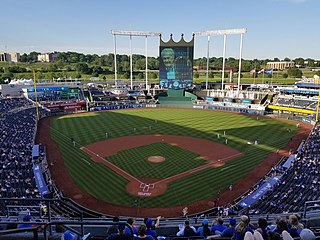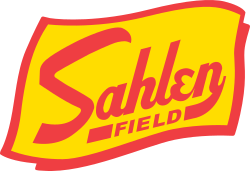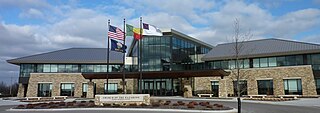
Minute Maid Park, rebranding to Daikin Park on January 1, 2025, is a retractable roof stadium in Houston, Texas, United States. It opened in 2000 and is the home ballpark of the Houston Astros of Major League Baseball. The ballpark has a seating capacity of 41,168, which includes 5,197 club seats and 63 luxury suites with a natural grass playing field. It was built as a replacement for the Astrodome, the first domed sports stadium ever built, which opened in 1965.

Progressive Field is a baseball stadium in the downtown area of Cleveland, Ohio, United States. It is the ballpark of the Cleveland Guardians of Major League Baseball and, together with Rocket Mortgage FieldHouse, is part of the Gateway Sports and Entertainment Complex. It was ranked as MLB's best ballpark in a 2008 Sports Illustrated fan opinion poll.

Kauffman Stadium is a baseball stadium located in Kansas City, Missouri. It is the home ballpark of Major League Baseball's Kansas City Royals. It is next door to Arrowhead Stadium, home of National Football League's Kansas City Chiefs. Both make up the Truman Sports Complex. The stadium is named for Ewing Kauffman, the founder and first owner of the Royals. It opened in 1973 as Royals Stadium and was named for Kauffman twenty years later on July 2, 1993. Since its last major renovation in 2009, the listed seating capacity is 37,903.

Oriole Park at Camden Yards, commonly known as Camden Yards, is a baseball stadium in Baltimore, Maryland. It is the ballpark of Major League Baseball's Baltimore Orioles, and the first of the "retro" major league ballparks constructed during the 1990s and early 2000s. It was completed in 1992 to replace Memorial Stadium. The stadium is in downtown Baltimore, a few blocks west of the Inner Harbor in the Camden Yards Sports Complex.

Sahlen Field is a baseball park in Buffalo, New York, United States. Originally known as Pilot Field, the venue has since been named Downtown Ballpark, North AmeriCare Park, Dunn Tire Park, and Coca-Cola Field. Home to the Buffalo Bisons of the International League, it opened on April 14, 1988, and can seat up to 16,600 people, making it the highest-capacity Triple-A ballpark in the United States. It replaced the Bisons' former home, War Memorial Stadium, where the team played from 1979 to 1987.
The Truman Sports Complex is a sports and entertainment facility in Kansas City, Missouri. It includes two major league sports venues: GEHA Field at Arrowhead Stadium, which is home to the National Football League's Kansas City Chiefs, and Kauffman Stadium, which hosts Major League Baseball's Kansas City Royals. The complex also hosts various other events during the rest of the year.

PNC Park is a baseball stadium on the North Shore of Pittsburgh, Pennsylvania. It is the fifth location to serve as the ballpark of Major League Baseball's Pittsburgh Pirates. Opened during the 2001 MLB season, PNC Park sits along the Allegheny River with a view of the Downtown Pittsburgh skyline. Constructed of steel and limestone, it has a natural grass playing surface and can seat 38,747 people for baseball. It was built just to the east of its predecessor, Three Rivers Stadium, which was demolished in 2001.

The Gateway Sports and Entertainment Complex is an entertainment complex located in downtown Cleveland, Ohio. It opened in 1994 and is owned by the city of Cleveland and Cuyahoga County and is managed by the Gateway Economic Development Corporation, a non-profit group with board members who are appointed by county and city leaders.

Four Winds Field at Coveleski Stadium is a baseball stadium in South Bend, Indiana, home to the South Bend Cubs, a minor league baseball team which plays in the Midwest League. The stadium opened in 1987, and its open concourse is considered the template for many later minor league ball parks built in the 1990s. It has a capacity of 5,000 spectators.

A ballpark, or baseball park, is a type of sports venue where baseball is played. The playing field is divided into two field sections called the infield and the outfield. The infield is an area whose dimensions are rigidly defined in part based on the placement of bases, and the outfield is where dimensions can vary widely from ballpark to ballpark. A larger ballpark may also be called a baseball stadium because it shares characteristics of other stadiums.

Busch Stadium is a baseball stadium located in St. Louis, Missouri. It is the home of Major League Baseball's St. Louis Cardinals. It has a seating capacity of 44,383, with 3,706 club seats and 61 luxury suites. It replaced Busch Memorial Stadium and occupies a portion of that stadium's former footprint. A commercial area dubbed Ballpark Village was built adjacent to the stadium over the remainder of the former stadium's footprint.

HOK Group, Inc., formerly Hellmuth, Obata + Kassabaum, is an American design, architecture, engineering, and urban planning firm. Founded in 1955, it is headquartered in St. Louis, Missouri.

A multi-purpose stadium is a type of stadium designed to be easily used for multiple types of events. While any stadium could potentially host more than one type of sport or event, this concept usually refers to a design philosophy that stresses multifunctionality over speciality. It is used most commonly in Canada and the United States, where the two most popular outdoor team sports—Canadian football or American football and baseball—require radically different facilities. Football uses a rectangular field, while baseball is played on a diamond with a large outfield. Since Canadian football fields are larger than American ones, the design specifications for Canadian facilities are somewhat less demanding. The particular design to accommodate both is usually an oval, although some later designs use an octorad. While building stadiums in this way means that sports teams and governments can share costs, it also presents some challenges.

360 Architecture was an American architectural practice acquired by HOK in 2015. The firm provided services for a range of project types including corporate headquarters and commercial office buildings, sports arenas, stadiums and ballparks, municipal facilities, single- and multi-family residential, and mixed-use entertainment districts. The firm was headquartered in Kansas City, Missouri, with offices in Columbus Ohio; and San Francisco, California. As of 2014, the firm had a staff of 200 professionals.
Rays Ballpark was the name used in project documents for a ballpark in the current location of Al Lang Stadium on the Tampa Bay waterfront in downtown St. Petersburg, Florida, proposed by the Tampa Bay Rays as a replacement for Tropicana Field.

Oneok Field is a baseball park in Tulsa, Oklahoma. Located in the historic Greenwood district adjacent to downtown Tulsa, it is the home of the Tulsa Drillers of the Texas League. The stadium is named for Oneok.

LoanDepot Park is a retractable roof stadium located in Miami, Florida, United States. It is the ballpark of Major League Baseball's Miami Marlins. It is located on 17 acres (6.9 ha) on the site of the former Miami Orange Bowl in Little Havana about 2 miles (3 km) west of Downtown Miami. Construction was completed in March 2012 for the 2012 season.

Children's Mercy Park is a soccer-specific stadium in Kansas City, Kansas, United States, and is the team home for Sporting Kansas City of Major League Soccer (MLS). The stadium is located near Kansas Speedway, on the far west side of Wyandotte County, Kansas. It opened during the 2011 MLS season on June 9, 2011, with a match against the Chicago Fire. The stadium has a seating capacity of 18,467, which can expand to 25,000 for concerts. Most SKC games attract around 21,000 spectators because of different stadium modes. The stadium is Sporting Kansas City's third home venue; then known as the Kansas City Wizards, the team played in Arrowhead Stadium from 1996 to 2007 and CommunityAmerica Ballpark from 2008 to 2010. In 2013, the stadium hosted the MLS All-Star Game, the United States men's national soccer team, and the MLS Cup, and is the only stadium to host all three in the same year.

Janet Marie Smith is a Major League Baseball (MLB) executive, architect, and urban planner. Smith has built and managed renovations of several major and minor league baseball parks in the United States including Baltimore, Atlanta, Boston, and Los Angeles. She became one of the first women to hold an executive position with any Major League Baseball club when she was promoted to Vice President of Planning and Development with the Baltimore Orioles in 1989. Smith is best known for her work developing Oriole Park at Camden Yards, which set a new standard for ballparks "incorporating historic, old-fashioned ballpark architecture with state-of-the-art modern conveniences." Through her work, Smith has demonstrated how to seamlessly blend the best elements of the past with those of the future.

Ron Labinski was an American architect, notable for influential designs of stadiums for professional baseball and football. Focusing for much of his career on sports venues, Labinski was instrumental in establishing sports and assembly venue design as architectural specialties. Labinski's work led to the establishment of several such specialized firms in Kansas City, composed of many of Labinski's former colleagues, making Kansas City the center of sports-related design. Labinski has been described as the world's first sports venue architect.


















